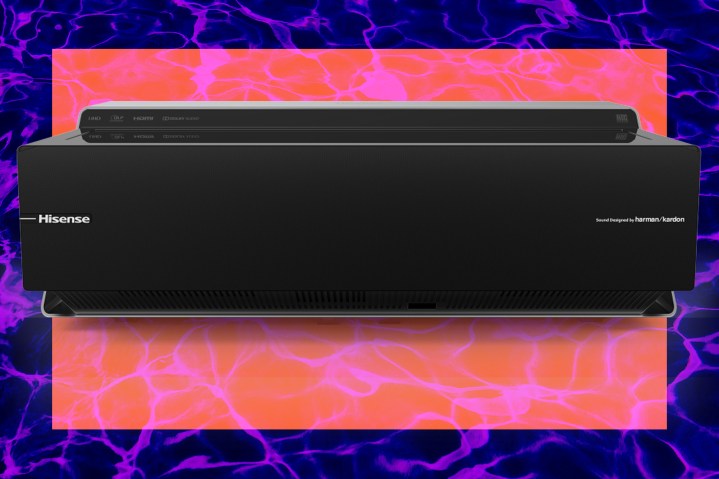
It’s impossible not to lead this story with a worn-out, predictable lament about being stuck at home most of 2020. The struggle to keep my two kids entertained has been real, so I’ll cop to loosening rules on screen time with zero shame. But what do you do when watching movies — once considered the occasional treat — becomes de rigueur?
My solution? Make movie night at home feel like a proper night out at the movies, complete with fresh-popped buttery popcorn, fizzy soda, trashy candy, and a massive projection screen. That last element is where an Ultra Short Throw (UST) projector comes in — specifically the Hisense 100L10E Laser TV
Like many folks, I have a wall big enough for a projection screen, but I don’t have the space for a conventional rear-projection system. Thankfully, UST projectors make big-screen dreams a more attainable reality and have become increasingly common and more affordable.
A UST projector eliminates most of the headaches and hassles involved with conventional rear projectors by sitting directly under a projector screen on an entertainment cabinet or even the floor — there’s no complicated projector mounting, no running HDMI and power cables across the room, no accidentally walking through the image. UST projectors also have a brightness advantage since light doesn’t have to travel long distances before hitting the screen. And with the right kind of screen, ambient light can be rejected, resulting in better contrast, even if the window shades are open.
Movie night revolutionized
Hisense got into the UST projector game pretty early and is now on its third generation of these products. Late last year, the company sent me its second-generation, dual-laser powered 100L10E projector with a 100-inch screen for evaluation. Movie night hasn’t been the same since.
With 85-inch TVs coming in under $2,000 these days, a $4,000 projector and screen might seem like a hard sell, even if it is considerably larger. Size does matter when it comes to a cinematic experience, though, and I’ve found watching movies and TV shows on a 100-inch screen considerably more entertaining than watching on either of the 65-inch TVs in my house. There’s something to the scale and motion of the images that makes the space feel more like a boutique theater than a living room.

Hisense calls the 100L10E a TV, and that’s because it is more than just a projector. With a built-in speaker system, wireless subwoofer, TV tuner, and a smart TV interface with apps like Netflix and Hulu built-in, the 100L10E fulfills every function of a conventional TV and then some.
Marketing folks throw the term “immersion” around all too frequently, but there really is a therapeutic aspect to experiencing the suspension of disbelief. It helps transport you to a far-off land or place you in the center of the action at a time when, in reality, we aren’t going anywhere or experiencing much of any kind of action that doesn’t involve seeing what Amazon delivered that day.
That very tangible feeling is something the Hisense 100L10E — and UST projectors in general — do better than conventional TVs.
Invaluable experiences
For its part, the Hisense 100L10E delivers stunning image fidelity. It has sharp 4K resolution, gets bright enough to bring punch to HDR highlights, maintains solid black levels for excellent contrast, and its colors are rich and vivid. And while I use a larger home theater speaker setup, the built-in Harman Kardon 2.1 speaker system is powerful enough to shake a large room.
Every time another movie is released in 4K HDR, I look forward to watching it on this setup. Plus, as my kids will assure you, if you haven’t played a four-person split-screen Mario Kart race on a huge screen, you aren’t doing COVID times right.
Frankly, this projector setup has been invaluable over the past few months. It’s drawn my family closer together and allowed us to have experiences that remind us that better times are just around the corner. We may not be able to get into a real commercial theater for a while, but the cinematic experience we are fortunate to enjoy at home will tide us over just fine.
Editors' Recommendations
- Optoma’s CinemaX 4K laser projectors now have faster response times for gamers
- Digital Trends staff picks: Our favorite tech gear of 2021





